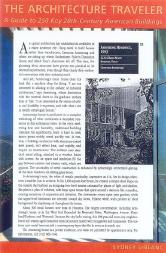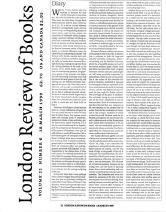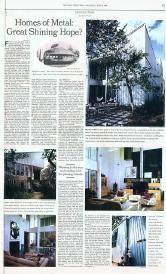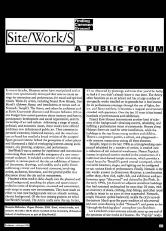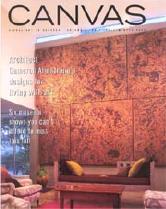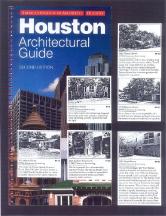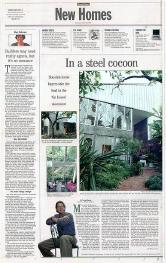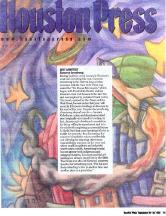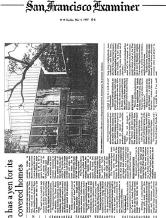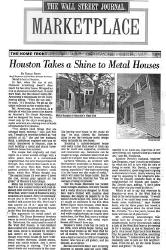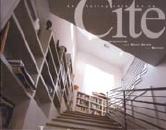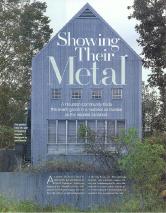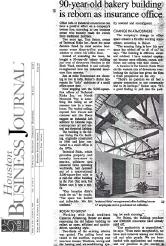Sydney LeBlanc, The Architecture Traveler: A Guide to 250 Key 20th-Century American Buildings
The building "... is predicated on a complete re-thinking of what constitutes a desirable residence in this subtropical town. In the city's sweltering heat and humidity, traditional building materials fail significantly: brick is hard to cool; stucco grows mouldy; wood quickly rots. In contrast, a building constructed with aluminum-coated steel panels will reflect heat, cool rapidly, and require no maintenance."
Alan Hollinghurst, London Review of Books
"...Armstrong speaks of the influence of the great Viennese architect Rudolph Schindler, who worked so inventively in the climatic conditions of his adopted California; and certainly the interiors of Armstrong's own house and of others he shows me round display a refined Modernist apprehension of the ever-changing subtleties of light, the multiplicity of whites, and the ambiguous margins between inside and outside. There is grandeur and intimacy, and surprising relations between the two."
Donna Paul, The New York Times
"Sitting quietly, luminuous and sleek... they seem at once warm and elegantly cool... After seeing other houses Mr. Armstrong built, his neighbor Suzanne Dungan commissioned him to build one for her... with expansive views of the front garden through the double-height living room, which is a soulful core of light."
Rainey Knudson, Canvas
"Armstrong's designs are practical as well as aesthetic. Not only do they gracefully house art; they also cut their owners' electricity bills dramatically."
Helen Thompson, Metropolitan Home
" 'One of the things that caught me by surprise,' says [owner] Suzanne Dungan, 'is how many reflections we got. The sky, the sunset, the clouds... so the interiors change depending on the time and the weather.' Although the original intention of the architect and homeowners was to enhance the artwork, in its heightened interaction with the environment, the house did something more. 'The house became part of the art,' says Suzanne."
SELECTED BIBLIOGRAPHY/PUBLICATIONS/MEDIA
(Recent publications available on request)
2001
"New Blue: Recent Work of Graduates of Yale School of Architecture, 1978-1998:" catalogue entry illustrating 5423 Gibson, Houston. Essays by Aaron Betsky and Vincent Scully. (New Haven, 2001).
"Past Imperfect: Can Modern Design and Historic Preservation Mix?" by David Theis: reported Armstrong's position on historic preservation in Houston's Sixth Ward neighborhood. Cite, The Architecture and Design Review of Houston (Houston, #51 - Summer 2001).
"Special Affections," by Kathy Huber: color feature described integration of landscape and architecture at 2017 Lubbock, Houston. Texas Magazine/Houston Chronicle (Houston, August 19, 2001).
"Site/Work/S: A Public Forum:" an account of the Site/Work/S -- International Sculpture Conference meeting of June 2000 included formal remarks, a transcript of the panel discussion, and photographs of works commissioned by Site/Work/S. Panellists included: John Davidson (Moderator), Jack Massing and Michael Galbreath (The Art Guys), Surpik Angelini, Tracy Hicks, Stephen Fox and Cameron Armstrong (Site/Work/S). Sculpture (Washington D.C, Vol.20 No.6, July/August, 2001).
Snapshot entry in the Rice Design Alliance's catalogue of its show at Lawndale Art and Performance Space illustrated 2020 North Memorial Way, Houston. Rice Design Alliance (Houston, 2001).
"Deconstructing TemplO," by Brad Tyer: reported Armstrong's remarks concerning the demolition of the TemplO compound in Houston. Houston Press (Houston, Vol.12 #12, Mar 22-28, 2001).
2000
The Lynette Jennings Program, on The Discovery Channel, focused on 5303 Floyd with a thirty minute program, including a room by room tour and views of the exterior. The Discovery Channel (October 6, 2000).
"Interview with Cameron Armstrong and Alexandra Irvine," by Chas Bowie, described Armstrong's role in organizing Site/Work/S and, in an interview together with Site/Work/S Curator Alexandra Irvine, addressed ideas on site specific art, civic monuments and Houston's site works. Canvas (Houston, Fall 2000).
"Sculpture On Site," by Mitchell Shields, described the installation of several large sculptures to inaugurate Project Row Houses' outdoor sculpture park as part of Armstrong's Site/Work/S project for the 18th International Sculpture Conference - Houston 2000. Cite, The Architecture and Design Review of Houston (Houston, #48 - Summer 2000).
"Steeling Home," by David Dobbs, described 604 Malone (the Bergman-Devich house) in words and pictures, focusing on the practical aspects of metal houses and their popularity. This Old House (New York, July/August, 2000).
"Site/Work/S Celebrates Houston's Public Art," by Rebecca Cohen, reviewed the indoor and outdoor sculpture installations, historical exhibition, and public forum organized as Site/Work/S by Armstrong in conjunction with the 18th International Sculpture Conference - Houston 2000, and co-sponsored by Houston Sculpture 2000, The Rice Design Alliance and Texas Architect magazine. Texas Architect (Austin, July-August 2000).
"From Hampstead to Houston," by Alan Hollinghurst, described CAA's work in an expanded version of his earlier "Diary" essay in The London Review of Books.. Gulf Coast, The Twentieth Anniversary Issue (Houston, Summer, 2000).
"The Architecture Traveler: A Guide to 250 Key Twentieth-Century American Buildings, Third Edition," by Sydney LeBlanc, included 5423 Gibson (text and photo, with contact information). (New York, Norton, June 2000).
"Sculpture Tsunami," by Patricia Johnson, described Armstrong's role in Site/Work/S, a program of indoor and outdoor sculpture installations, a historical exhibition, and a public forum held in conduction with the 18th International Sculpture Conference - Houston 2000, co-sponsored by Houston Sculpture 2000, The Rice Design Alliance and Texas Architect magazine. Houston Chronicle (Houston, May 31, 2000).
"Prestigioso arquitecto dicta charla," reported Armstrong's March 16 slide show and lecture at the Casa De Chavon de Santo Domingo. En Sociedad (Santo Domingo, April 22, 2000).
"Discovery Discovers Houston," a news magazine segment airing on KPRC/NBC, reported on the production of The Discovery Channel's Lynette Jennings coverage of 5303 Floyd (airing Fall, 2000). KPRC/NBC Evening News (Houston, March 22, 2000).
"Deep in the Heart of Houston," by Phillip Lopate, cited Armstrong's West End houses as examples of local architectural design. The New York Times Magazine/The Sophisticated Traveler (New York, February 27, 2000).
1999
"Bring on the Lawyers," by Shaila Dewan, quoted Armstrong on the subject of design patents. Architecture (New York, 12/99).
"American Institute of Architects' Houston Architectural Guide, Second Edition," cited 1225 Jackson Blvd., 5423 Gibson, 311 Asbury, 5419 Blossom, 604 Malone, 5303 Floyd and the renovation of 2020 North Memorial Way. The American Institute of Architects/Houston Chapter and Herring Press (Houston, 1999).
"Pushing Tin," by Helen Thompson, described 5303 Floyd (the Dungan house) in words and pictures. Metropolitan Home (NewYork, November-December, 1999).
"Room to Move" by Cameron Armstrong, reviewed the installation of "room," a work by Lars Lerup and Sohela Farokhi at The Menil Collection. ArtLies (Houston, Number 22, Spring 1999).
"Diary," an extended meditation by Alan Hollinghurst on his time in Houston, described Armstrong's work and its context. London Review of Books (London, Vol. 21 #6, 18 March 25, 1999).
"To Die For: In Death, Design Matters," by Mitchell Shields, focused on Armstrong's funerary designs in discussing the potential roles of architects and designers in providing support for grief and mourning. Cite, The Architecture and Design Review of Houston (Houston, #43 - Winter 1999).
"Saving Our History: The Underground Railroad," a two hour documentary on the pre Civil War route taken by escaped slaves on their way to Canada, featured views of Armstrong's 1977 monument, Underground Railroad. The History Channel (February 20-22, 1999).
1998
"Tin Is In," a segment appearing in the nightly magazine show "Weeknight Edition" focused on Armstrong's work and on the evolution of Houston's metal houses, and included an interview as well as interior and exterior views of the buildings. KUHT/PBS: Weeknight Edition (October 20, 1998).
"Cameron Armstrong's Designs for Living with Art," by Rainey Knudsen, described Armstrong's recent work and, in an interview, presented ideas on collecting and designing buildings to display art. Canvas (Houston, Fall/Winter 1998).
"Best Architect." Cameron Armstrong was named "Best Architect" by Houston's weekly newspaper as part of its annual "Best of Houston" survey. Houston Press (Houston, September 24-30, 1998).
"Homes of Metal: Great Shining Hope?" by Donna Paul, provided national full page color coverage of Armstrong's metal houses in the West End neighborhood, with an in depth profile of their history, construction and historical roots. The New York Times (New York, May 14, 1998).
1997
"Houston Refuels," by Stephen Fox, described the work of Armstrong and others in the West End neighborhood. Architecture (New York, August, 1997).
"Houston Works," the catalogue of the Rice Design Alliance's show of architectural work at Lawndale Art and Performance Space, included 311 Asbury, a house completed by Armstrong in 1996. Rice Design Alliance (Houston, 1997).
"In a Steel Cocoon," described aspects of Armstrong's recent design work, and included photographs by Brett Coomer. Chicago Tribune (Chicago, May 24, 1997).
"Remarkable New Architecture in Houston," featured Charles Zewe's interviews with Armstrong and Terrell James, and video footage of recent Armstrong designs. Cable News Network, CNN Science and Technology Report, CNN Headline News (May 15 - 18, 1997).
"Houston has a yen for its metallic covered homes," described the use of metal siding and other features of Armstrong's recent house designs. San Francisco Examiner (San Francisco, May 4, 1997).
"Latest Home Craze," featured Cynthia Cisneros' interviews with Armstrong, and client Suzanne Dungan, and video footage of recent Armstrong designs. Channel 13, Houston (6:00 News, May 1, 1997).
"Houston Takes a Shine to Metal Houses," by Terzah Ewing, featured Armstrong's designs, ideas, and interviews with three of his clients in describing the emergence of new architecture in Houston. Wall Street Journal (New York, April 25, 1997).
1996
"Where We Live: In Houston, Revitalization Hits and Misses," by Stephen Fox, referred to the 1994 renovation of 2020 North Memorial Way. Texas Architect (Austin, November-December 1996).
"The Right Angle," Tom Tynan's program, featured the stained concrete floors of 5423 Gibson and described finishing, staining and sealing techniques. CBS Evening News (August 4, 1996).
"90-year-old bakery building is reborn as insurance office," by Laura Floyd, described the renovation of a historic building at 2020 North Memorial Way, Houston, for use as an insurance company headquarters. Houston Business Journal (Houston, May 31, 1996).
1995
"Showing Their Metal," by Joseph Giovanini, featured an interview with Armstrong in describing the metal clad houses of Houston, including 5423 Gibson. Metropolitan Home (New York, July-August, 1995).
1994
"West End Story," by Jennifer Farley, described the changes in Houston's West End as a result of the Special District Zoning process led by Armstrong, the continuing debate about the area's future, new houses and construction techniques in the neighborhood, and the influx of commercial and development interests. Downtown Voice (Houston, June, 1994).
"Best Laid Plans," the catalogue of the Rice Design Alliance exhibition of architectural work at Lawndale Art and Performance Space, included "5419 Blossom: Work in Progress." Rice Design Alliance (Houston, 1994).
"Metal Structures Hide Design Gems" by Ann Holmes. Houston Chronicle (Houston, April 23).
"Tour of Sixth Ward tin houses scheduled by design group" by Roy Durrenberger. Houston Chronicle/This Weekend (Houston, April 23).
"Weekend Winners," photograph with caption. Houston Post (Houston, April 22).
"Tin houses: Tour examines architecture style" by Bob White. Houston Chronicle/This Week (Houston, April 20).
"Tin Fan Alley" by Deborah Mann Lake. Houston Post (Houston, April 16).
1993
"West End Special District," a comprehensive plan to structure the redevelopment of Houston's West End neighborhood, was drafted by Armstrong on behalf of area residents and formally presented to Houston's City Council under the guidelines of the then proposed Houston Zoning Ordinance. At the time of the zoning law's electoral defeat, the W.E.S.D. was the city's only ongoing special district project. Houston City Council Record (Houston, March 30, 1993).
"Retracing Freedom's Route to Oberlin" described the Underground Railroad monument (1977). New York Times (New York, April 1993).
